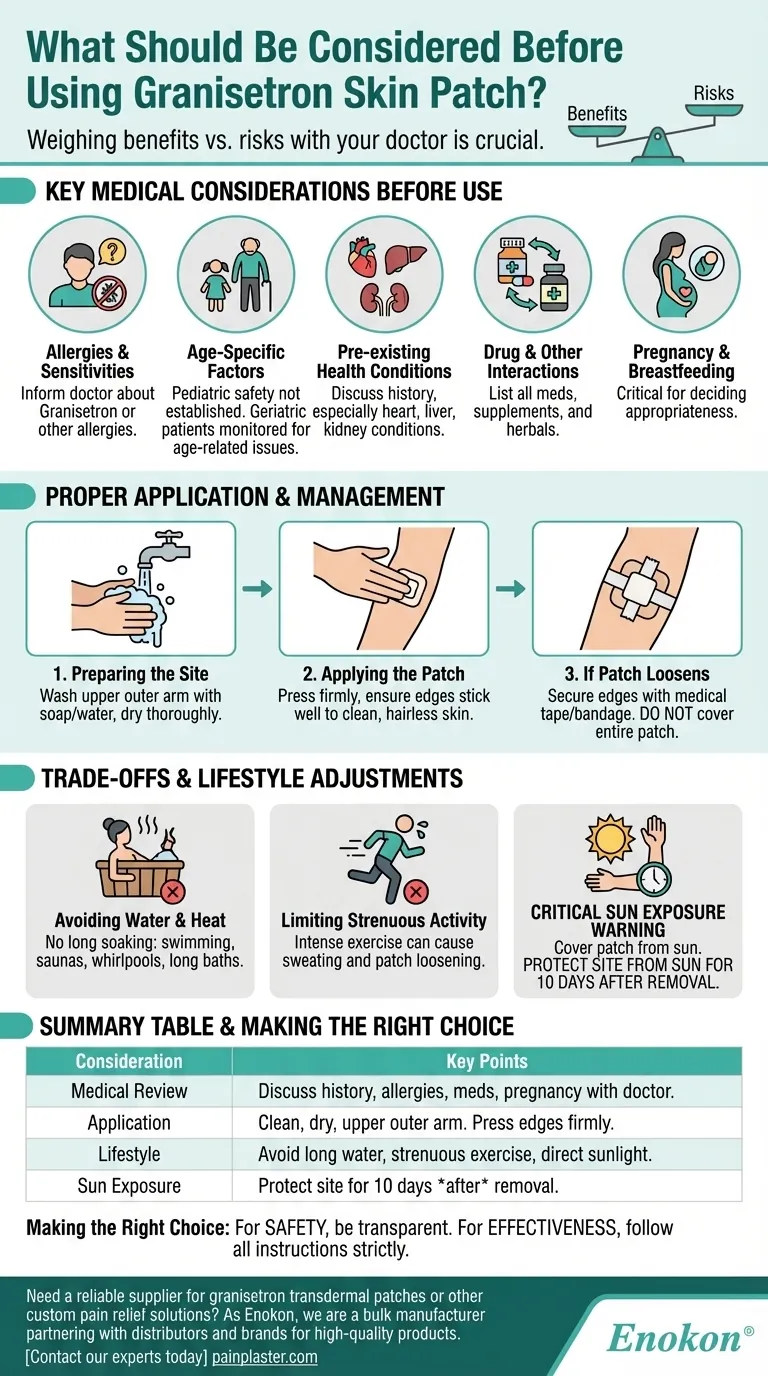Before using a granisetron skin patch, you must weigh the benefits against the risks by discussing several key factors with your doctor. These considerations include any known allergies, your age, other medical conditions you have, all other medications you are taking, and whether you are pregnant or breastfeeding.
The granisetron patch is a powerful tool for preventing chemotherapy-induced nausea, but its safety and effectiveness depend on two things: a thorough medical review with your doctor beforehand and strict adherence to lifestyle guidelines while wearing it.

Key Medical Considerations Before Use
Your healthcare provider needs a complete picture of your health to determine if the granisetron patch is a safe option for you. Open communication about your medical history is the critical first step.
Allergies and Sensitivities
You must inform your doctor if you have ever had an allergic reaction to granisetron or any similar medications. Disclose any other allergies you have, such as to foods, dyes, or preservatives.
Age-Specific Factors
For pediatric patients, the safety and efficacy of the granisetron patch have not been established.
For geriatric patients, no specific problems have been documented that would limit its use. However, elderly patients are more likely to have age-related heart, liver, or kidney problems, which requires caution.
Pre-existing Health Conditions
It is essential to discuss your full medical history. Conditions related to the heart, liver, or kidneys are particularly important, as they can influence how your body processes the medication.
Drug and Other Interactions
Provide your doctor with a complete list of all prescription and non-prescription medicines, supplements, and herbal products you are taking. Drug interactions can alter the effectiveness of the patch or increase the risk of side effects.
Pregnancy and Breastfeeding
Inform your doctor if you are pregnant, planning to become pregnant, or currently breastfeeding. This is a critical factor in deciding if the patch is appropriate for you.
Proper Application and Management
How you apply and care for the patch directly impacts its performance. Following these steps ensures the medication is delivered correctly and consistently.
Preparing the Application Site
First, wash your hands and the application area with plain soap and water, then dry thoroughly. Apply the patch to a clean, dry, and nearly hairless patch of skin on your upper outer arm.
Applying the Patch
Press the patch firmly onto your skin, paying special attention to the edges to ensure they stick well.
If the Patch Loosens
If the patch edges begin to lift, you can secure them with medical adhesive tape or a surgical bandage placed only around the edges. Do not cover the entire patch, as this can interfere with how the medication works.
Understanding the Trade-offs and Lifestyle Adjustments
Using a skin patch requires you to be mindful of certain activities and environmental exposures that can affect its adhesion and performance.
Avoiding Water and Heat
While wearing the patch, you must avoid soaking it for long periods. This means refraining from swimming, using saunas or whirlpools, and taking long baths or showers.
Limiting Strenuous Activity
Strenuous exercise can cause excessive sweating, which may loosen the patch. It's best to avoid intense physical activity while the patch is on.
The Critical Sun Exposure Warning
The skin where the patch is applied is sensitive to sunlight. You must keep the patch itself covered and away from direct sunlight. After you remove the patch, you must continue to protect that area of skin from sunlight for an additional 10 days.
Making the Right Choice for Your Treatment
Your active participation in your treatment plan is essential for achieving the best possible outcome.
- If your primary focus is safety: Be completely transparent with your healthcare provider about your entire medical history, allergies, and all other medications you are taking.
- If your primary focus is effectiveness: Strictly follow all instructions for application, daily care, and activity limitations, especially the warnings regarding water, heat, and sun exposure.
Understanding these factors empowers you to use the granisetron patch safely and effectively as a part of your cancer treatment plan.
Summary Table:
| Consideration | Key Points |
|---|---|
| Medical Review | Discuss allergies, age, medical history, other medications, and pregnancy/breastfeeding status with your doctor. |
| Application | Apply to clean, dry, hairless skin on the upper outer arm. Press edges firmly. |
| Lifestyle Adjustments | Avoid long water exposure, strenuous exercise, and direct sunlight on the patch area. |
| Sun Exposure | Protect the application site from sunlight for 10 days after patch removal. |
Need a reliable supplier for granisetron transdermal patches or other custom pain relief solutions?
As Enokon, a bulk manufacturer of reliable transdermal patches and pain plasters, we partner with healthcare and pharmaceutical distributors and brands. Benefit from our technical expertise for custom R&D and development to ensure you have a high-quality, effective product for your patients.
Contact our experts today to discuss your specific needs.
Visual Guide

Related Products
- Natural Herbal Wormwood Patch Pain Plaster
- Far Infrared Deep Heat Relief Patches Medicated Pain Relief Patches
- Capsaicin Chili Medicated Pain Relief Patches
- Mugwort Wormwood Pain Relief Patch for Neck Pain
- Lidocaine Hydrogel Pain Relief Patch for Pain Relief
People Also Ask
- What medical conditions should be reported before using buprenorphine patches? Essential Safety Guide
- Who should consult a healthcare professional before using pain relief patches? Ensure Your Safety with Medical Advice
- What was the reported pain relief after the initial month of plaster use? Consistent & Effective Pain Management
- What precautions should be taken when using pain relief patches? Essential Safety Guide
- Are pain relief patches safe for sensitive skin? Your Guide to Safe Use & Skin Testing














